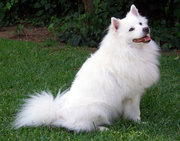
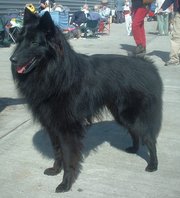
Coat colors range from pure white to solid black and many other variations.
|
Dog breeds, anatomy of all dog breeds |
The anatomy of Dogs varies tremendously from breed to breed, more than in any other animal species, wild or domesticated. And yet there are basic physical characteristics that are identical among all Dogs, from the tiny Chihuahua to the giant Irish Wolfhound.
Like most predatory mammals, the Dog has powerful muscles, a cardiovascular system that supports both sprinting and endurance, and teeth for catching, holding, and tearing.
The Dog's ancestral skeleton provided the ability to run and leap. Their legs are designed to propel them forward rapidly, leaping as necessary, to chase and overcome prey. Consequently, they have small, tight feet, walking on their toes; their rear legs are fairly rigid and sturdy; the front legs are loose and flexible, with only muscle attaching them to the torso.
Although selective breeding has changed the appearance of many breeds, all Dogs retain the basic ingredients from their distant ancestors. Dogs have disconnected shoulder bones (lacking the collar bone of the human skeleton) that allow a greater stride length for running and leaping. They walk on four toes, front and back, and have vestigial dewclaws (Dog thumbs) on their front and rear legs just like monkeys' thumbs. In some cases these claws are missing due to surgery, the rear dewclaws sometimes being removed to prevent the possibility of them being ripped off, or catching on something and breaking, especially in Dogs with loose dewclaws. This practice is illegal in some countries.
The Dog's ancestor was about the size of a Dingo, and its skeleton took about 10 months to mature. Today's toy breeds have skeletons that mature in only a few months, while giant breeds such as the Mastiffs take 16 to 18 months for the skeleton to mature. Dwarfism has affected the proportions of some breeds' skeletons, as in the Basset Hound.


Coat colors range from pure white to solid black and many other variations.
Dogs exhibit a diverse array of coat textures, colors, and markings, and a specialized vocabulary has evolved to describe them.
Originally, Dogs all had dense fur with an undercoat and long muzzles and heads, although both of these features have been altered in some of the more extremely modified breeds, such as the Mexican Hairless Dog and the English BullDog.
Color
One often refers to a specific Dog first by coat color rather than by breed; for example, "a blue merle Aussie" or "a chocolate Lab". Coat colors include:
Pattern
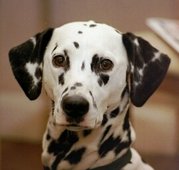 The Dalmatian's
coat is one of the more widely recognized markings.
The Dalmatian's
coat is one of the more widely recognized markings.
Coat patterns include:
Texture
Coat textures vary tremendously. Some coats make the Dogs more cuddly and others make them impervious to cold water. Densely furred breeds such as most sled Dogs and Spitz types can have up to 600 hairs per inch, while fine-haired breeds such as the Yorkshire Terrier can have as few as 100, and the "hairless" breeds such as the Mexican Hairless have none on parts of their bodies. The texture of the coat often depends on the distribution and the length of the two parts of a Dog's coat, its thick, warm undercoat (or down) and its rougher, somewhat weather-resistant outer coat (topcoat, also referred to as guard hairs). Breeds with soft coats often have more or longer undercoat hairs than guard hairs; rough-textured coats often have more or longer guard hairs. Textures include:
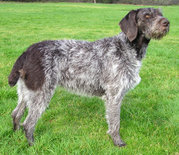 The
German Wirehaired Pointer's coat demonstrates a rough texture.
The
German Wirehaired Pointer's coat demonstrates a rough texture.
A special vocabulary has been developed to describe the shapes of various body parts including the ears and tail.
Ears
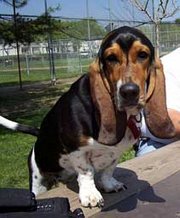 The
Basset Hound's ears are extremely long drop ears.
The
Basset Hound's ears are extremely long drop ears.
Dogs' ears come in a variety of sizes, shapes, lengths, positions on the head, and amounts and types of droop. Every variation has a term, including:
Tails
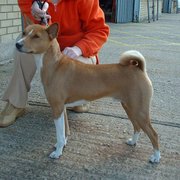 The Basenji's
tail is tightly curled.
The Basenji's
tail is tightly curled.
Like ears, tails come in a tremendous variety of shapes, lengths, amounts of fur, and tailsets (positions). Among them:
Puppies often have characteristics that do not last beyond early puppyhood. Eye color often changes from blue to its adult color as the puppy matures. The coat color may change: Kerry Blue Terrier puppies have black coats at birth and change to blue with maturity, and Dalmatians are white and gain their spots with age. The ear shape will also often change, especially with erect-eared breeds such as the German Shepherd Dog which have soft ears at birth, but the cartilage strengthens with age.
It is not uncommon for puppies to have their ears cropped or straightened, tails docked, or in the case of the Chow Chow, to have their eyefolds stitched back so that they can see. Many of these are done in accordance with breed standards for many Kennel Clubs. Some countries like Italy have banned this practice as an act of animal cruelty.
A common misconception is that Dogs do not sweat. Primarily, Dogs regulate their body temperature in a completely different way, through their tongue. That is why after a Dog has been running or on a hot day, its mouth will be seen wide open with the tongue hanging out. This form of cooling maximizes heat lost while conserving moisture, because it carries heat from the hottest part of the body, the interior core of the thorax, unlike sweating, which cools the already coolest part of the body, the skin?or in less intuitive, more scientific terms, this higher efficiency of thermal loss relative to moisture conservation arises because heat flow is proportional to temperature gradient. In addition, Dogs effectively sweat through the pads of their feet, since they are not furred. On a warm day and after exercise, a Dog's naturally wet footprints might be visible on a smooth floor.
Dogs possess a rete mirabile in the carotid sinus at the base of their neck, a complex of intermingled small arteries and veins which acts as a heat exchanger to thermally isolate the head, containing the brain, the most temperature-sensitive organ, from the body, containing the muscles, where most of the heat is generated. The result is that Dogs can sustain intense physical exertion over a prolonged time in a hot environment, compared to animals which lack this apparatus; thus, a Dog chasing a jackrabbit through the desert may not be able to outrun the rabbit, but it can continue the chase until the rabbit literally drops dead from overheating.
anatomy of all dog breeds